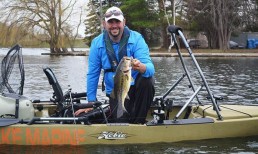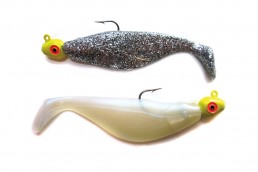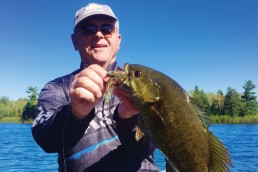Swim Jigs: Wherever they came from, they Work
SHARE THIS POST
Surf online to find out where swim jigs for bass came from and you’ll likely be able to narrow the source down to two places: The Mississippi River north of La Crosse, Wisconsin, and the Coosa River, in Alabama. Seems that a fellow named Tom Monsoor ruled tournaments in the La Crosse area some 30 years ago, and eventually spilled the beans that swimming a jig through shallow weeds was his top presentation. Supporters of the Coosa River origin claim other folks down in Alabama started purposely swimming a jig about the same time.
Most people fishing with this simple tactic of swimming a jig for bass these days probably could not care less if the technique started in Wisconsin or Alabama. Wherever it came from, it flat out works. Not only is it effective, but it’s one of those techniques that pretty much works any time there isn’t ice covering the lakes. Oh, and it’s deadly in some river situations, too.
Swim jigs became mainstream for bass probably about seven years ago when some big Bassmaster events started getting won with them. I wish I would have figured it out a long time ago. Even as a kid fishing tournaments with my dad or my Uncle Jim, there were lots of times that I’d be working a jig back in the traditional, lift, shake, lift retrieve along the bottom, but the bass didn’t bite until I started cranking the jig in fast to make another cast. It never occurred to me to start swimming that jig as soon as it hit the water.
These days, swimming a jig is a standard presentation for me, and I almost always have a swim jig rigged and ready to go up on the front deck of my Nitro bass boat.
How to swim a jig
For anyone who hasn’t tried one, or tried one without success, let’s talk about the basics. The swim jig is one of those lures that you’re best off not overthinking. Usually, catching fish on one is a simple matter of casting it out and winding it back at a steady pace, much like you would a spinnerbait. Generally, you want it either up near the surface looking like a baitfish to the bass below, or coming through cover into a bass’s face and causing a reaction strike. Oh, let’s add slow-reeling it along the bottom to mimic a crawfish or goby or other tasty bottom-dweller puttering along.
Actually, you can never be too creative about where to throw one, and what kind of trailer to put on it.
For instance, take this river scenario: It’s common knowledge that trout like to hide underneath washed-out embankments; not-too-common knowledge that bass do the same thing in warmer rivers. One of the best ways to catch these bass is to position your boat (or actually wade) downstream of the undercut, as close to the bank as possible and cast a swim jig upstream, parallel to the bank. I like using a Strike King Hack Attack Heavy Cover Swim Jig, 1/4- to 5/8-ounce size, with a Rage Tail trailer, which really thumps. Reel just fast enough to keep the trailer moving as you come downstream and you might be surprised at how many bass you’ll catch out of a spot like this. Sure, you could use a crankbait in this situation, but the swim jig is far less likely to get hung up as you bring it downstream.
Narrow-nose or “bullet-head” swim baits along the lines of the KVD Swim Jig from Strike King and the Stealth Jig from Freedom Tackle are excellent for pulling through weeds. One of the KVD models has rattles on it, which cause a nice little commotion that seems to trigger strikes. The Stealth Jig from Freedom Tackle is basically a swimbait head with a skirt and a big offset, wide-gap hook onto which you ‘Texas rig’ a trailer. It’s nice and weedless, and the hook is actually on a corkscrew sort of arrangement that allows it to swivel, which adds some wiggly action with a swimming plastic trailer.
Most of the time I throw swim jigs on a heavy-action rod, with the G.Loomis, 7-foot, 6-inch Jig and Worm Rod (model GLX 904) my favorite. For the reel, I like the Shimano Curado with a 6.4:1 retrieve ratio. That’s a fairly fast retrieve, which is important with swim jigs because of how bass sometimes hit it. They frequently smoke it from behind, and keep swimming at you—all of a sudden you just feel kind of “nothing” as you reel. When this happens, crank like mad until you catch up with the fish and then set the hook. If you make a big swing before your reel picks up the slack, your rod tip will be behind your head, and you’ll have to try and drive the hook point home with just the reel handle. This doesn’t work very well.
Are you enjoying this post?
You can be among the first to get the latest info on where to go, what to use and how to use it!
For line with a swim jig, 14-pound-test fluorocarbon is a good compromise between invisibility and durability around the kinds of brush you often throw this thing into.
As for trailers, some imitate crawfish and some are just paddle-tail swimbaits. Both of them work, and usually, both are imitating baitfish and not crawfish. That’s because crawfish don’t swim up in the water column where you’re usually pulling these lures. The exception, of course, is when you’re slow rolling a swim jig right on bottom, which is where the crawfish hang.
So when picking your trailer—and lots of things from the Strike King Rage Lobster to a plain, 3-inch Kalin Grub make great trailers—pick a color that matches the primary forage. In Michigan, lots of times, that’s going to be bluegills, perch and sunfish. In lakes connected to the Great Lakes, you might go with a more silver presentation to mimic alewives and shiners.
Color choice is also important as to where you’re fishing in a specific lake. If you’re pulling your swim jig through weeds, a darker panfish color is usually the best way to go. If you’re buzzing it up on top close to the surface, it often pays to opt for a lighter color that blends with the silver, shimmery surface the bass are looking up into. You don’t want that fish to see your bait all that clearly, and so a silvery, pearly white bait works better most of the time.
One of the really great things about fishing a swimming jig is not just how well it catches fish, but how many different combinations of colors and trailers you can put together to find the one that works best in any given body of water. Start with something that matches the hatch of prey fish and that moves some water to send out vibrations that feel like a fleeing meal to a bass. Then tweak it from there. Stick with a swim jig, tweak the colors and action, and odds are good you will find one that catches fish.
Tournament angler and avid outdoorsman Buck Mallory of Lawton writes Michigan-specific bass fishing articles for MidWest Outdoors.
Chatterbaits
Swim jigs evolved into the Chatterbait from Z-Man, which is a jig with a blade in front of it that gives the jig body, skirt and trailer a whole lot of action. Strike King’s version is called the Pure Poison Swim Jig. These can be great lures about any time of year, but especially in cold water, when fish want something moving slowly, but with lots of action.
That’s what these baits provide—a lot of action. I’ve fared well with the black-bladed Chatterbait, and have found that sometimes toning down the flash of the Pure Poison Swim Jig with a black magic marker can make that lure get more hits.
Like the standard swim jig, there’s no big secret to effectively fishing the bladed swim jig. A standard chunk and wind procedure, dropping these baits into prime, mainly shallow bass habitat will get results.
MWO
SHARE THIS POST
Did you enjoy this post?
You can be among the first to get the latest info on where to go, what to use and how to use it!
Buck Mallory
Tournament angler and avid outdoorsman Buck Mallory of Lawton writes Michigan-specific bass fishing articles for MidWest Outdoors.



